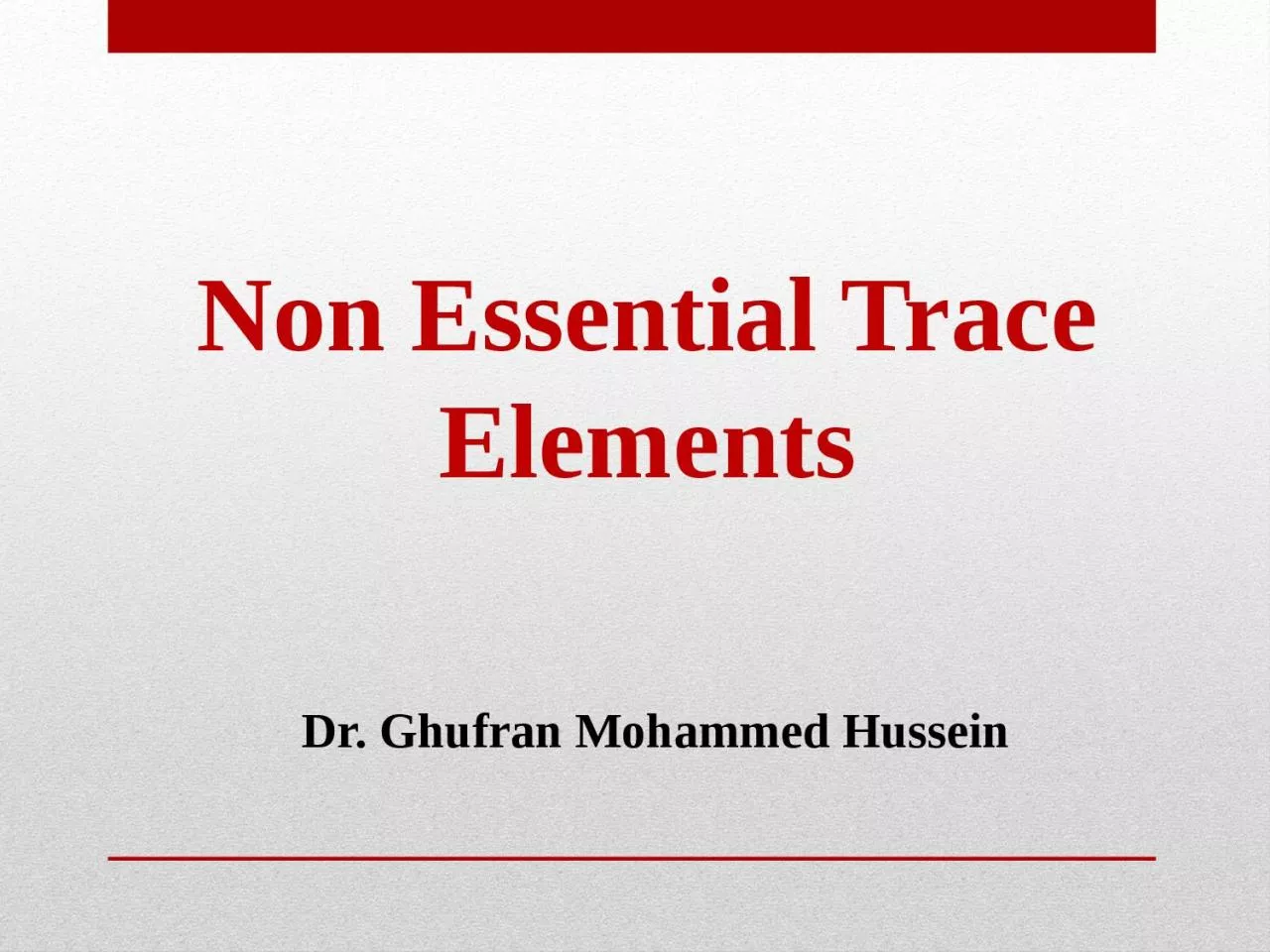

Dr Ghufran Mohammed Hussein Non Essential Trace Elements Non Essential trace elements are fluoride lead aluminum gold mercury lithium and silver The lack of any of these elements has not been shown to interrupt the life cycle or have a defined biochemical fu ID: 933204
Download Presentation The PPT/PDF document "Non Essential Trace Elements" is the property of its rightful owner. Permission is granted to download and print the materials on this web site for personal, non-commercial use only, and to display it on your personal computer provided you do not modify the materials and that you retain all copyright notices contained in the materials. By downloading content from our website, you accept the terms of this agreement.
Slide1
Non Essential Trace Elements
Dr.
Ghufran
Mohammed Hussein
Slide2Non Essential
Trace Elements
Non Essential trace elements
are
fluoride
,
lead
,
aluminum
,
gold
,
mercury
,
lithium and
silver. The lack of any of these elements has not been shown to interrupt the life cycle or have a defined biochemical function in humans; thus they are generally considered nonessential.
Slide31. Fluoride
Fluoride is commonly used in dentistry to strengthen enamel, which is the outer layer of your teeth.
Fluoride
anion increases the structural stability of teeth and bones through interactions with calcium phosphates, prevent dental caries.
Slide4Fluoride
Dental fluorosis
is
an extremely common disorder, characterized by
hypomineralization
of tooth enamel caused by ingestion of excessive fluoride during enamel formation. Dental fluorosis results in white spots on the surface of
teeth
.
Slide52. Lead
Its salts were used topically as astringent.
Inorganic lead can not pass through intact skin but it will absorbed through abraded
skin, while
organic l
ead
such as tetraethyl
lead
can penetrate skin rapidly.
After absorption,
the
lead
can be found initially in the erythrocyte and soft tissue. Later the kidneys
and liver contain
the most
lead.
Slide6Lead poisoning
Chronic
l
ead
poisoning manifests itself by inhibition of
heme
synthesis
The most serious
lead
poisoning symptoms
are
encephalopathy
(which
is more common in
children) and renal damage
Slide7Treatment of lead poisoning
Treatment is based on the use of chelating agents to remove the accumulated
lead
from erythrocyte and soft
tissue
Dimercaprol and calcium disodium edetate are used initially followed by
pencillamine
Acute
poisoning from oral ingestion can be treated by administrating Na or Mg
sulphate
to precipitate the
lead
followed by gastric
lavage
Slide83. Aluminum
Soluble aluminum compounds are astringent and
antiseptic
The insoluble aluminum compounds are mostly used as non systemic antacid.
Slide94. Gold
Used in the rheumatoid arthritis, and therapeutic gold compounds are administered
IM.
Orally is poorly absorb and
irritant
Gold injections can be effective for some people, their use has declined dramatically in the last 20 years due to the severe side
affect
Slide105. Mercury
The
mercurous
Hg
+
and the mercuric Hg
+2
cations
are toxic, in addition that mercury vapor is toxic.
Organic
mercurial compounds are very toxic and are the cause of most reports of mercury poisoning.
Slide11Mercury
Toxic effects of mercury similar to that of lead due to its combining with protein sulfhydryl groups
After absorption
,
the mercuric cation concentrates mostly in kidney, with less concentration in liver, blood, bone marrow, and other
tissues
It is excreted by kidney and
colon
Acute poisoning usually occurs by ingestion of soluble mercuric salts, vomiting and diarrhea may result with diuresis (suppression of tubular reabsorption) and kidney damage.
Slide12Mercury
Mercurial salts are used as :
Diuretics
Antiseptics
Parasiticides
Fungicides
Slide13Mercury
Treatment of acute poisoning
Gastric lavage
Using
of reducing agent such as sodium formaldehyde
sulfoxylate
(to reduce the mercuric cation forming less soluble mercurous salt)
Using
of chelating agents such as dimercaprol or
pencillamine
Slide146. L
ithium
It is readily absorbed from
intestine,
accumulates in the body.
The
extent of its accumulation depends on sodium intake (decrease sodium intake accelerate lithium accumulation and potentiate toxicity)
Lithium intoxication is treated by withhold lithium and provide sodium
intake
Slide156. L
ithium
Lithium carbonate is administered orally in manic depressive disorder (used as a psychiatric medication
)
Lithium carbonate can affect thyroid function causing
myxedema (deficient
thyroid function
).
Slide167.
Silver
Silver generally has low toxicity, and minimal risk is expected when silver is used in approved medical
applications
Silver is added to some bandages for its antimicrobial effect
.
The
medical uses of silver include its use in wound dressings
, burn creams,
and as an antibiotic coating on medical
devices
Slide17Silver
sulfadiazine, a sulfa drug, is used to prevent and treat infections of
burns
Silver
Slide18